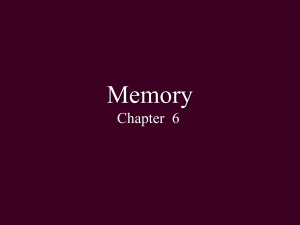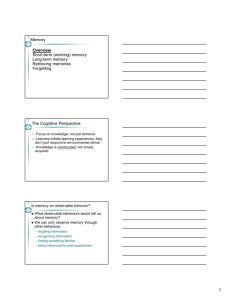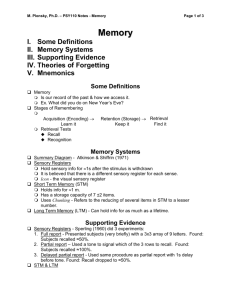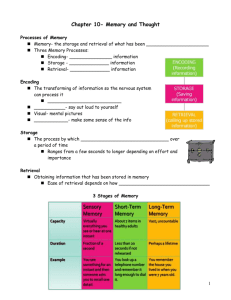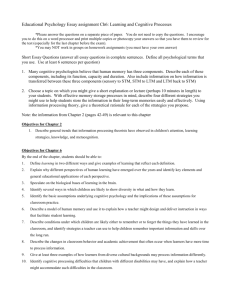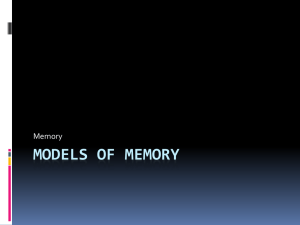Chap 6 - Memory
advertisement
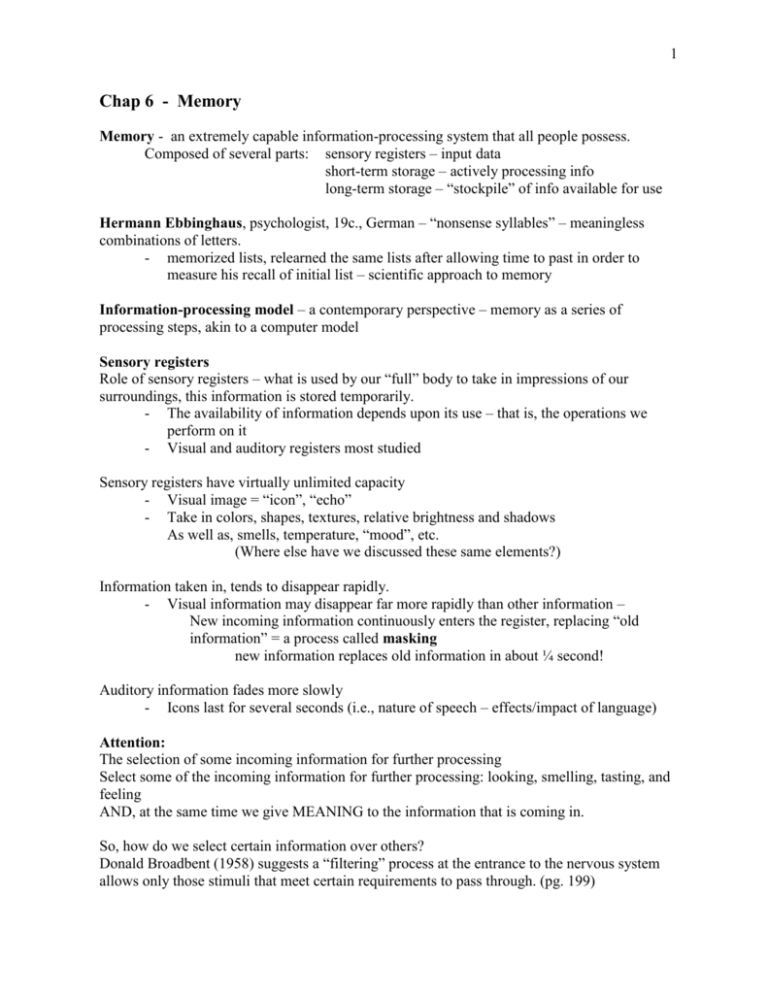
1 Chap 6 - Memory Memory - an extremely capable information-processing system that all people possess. Composed of several parts: sensory registers – input data short-term storage – actively processing info long-term storage – “stockpile” of info available for use Hermann Ebbinghaus, psychologist, 19c., German – “nonsense syllables” – meaningless combinations of letters. - memorized lists, relearned the same lists after allowing time to past in order to measure his recall of initial list – scientific approach to memory Information-processing model – a contemporary perspective – memory as a series of processing steps, akin to a computer model Sensory registers Role of sensory registers – what is used by our “full” body to take in impressions of our surroundings, this information is stored temporarily. - The availability of information depends upon its use – that is, the operations we perform on it - Visual and auditory registers most studied Sensory registers have virtually unlimited capacity - Visual image = “icon”, “echo” - Take in colors, shapes, textures, relative brightness and shadows As well as, smells, temperature, “mood”, etc. (Where else have we discussed these same elements?) Information taken in, tends to disappear rapidly. - Visual information may disappear far more rapidly than other information – New incoming information continuously enters the register, replacing “old information” = a process called masking new information replaces old information in about ¼ second! Auditory information fades more slowly - Icons last for several seconds (i.e., nature of speech – effects/impact of language) Attention: The selection of some incoming information for further processing Select some of the incoming information for further processing: looking, smelling, tasting, and feeling AND, at the same time we give MEANING to the information that is coming in. So, how do we select certain information over others? Donald Broadbent (1958) suggests a “filtering” process at the entrance to the nervous system allows only those stimuli that meet certain requirements to pass through. (pg. 199) 2 Information is compared to information already stored – is it recognizable? Then, we figure out what we mean. “Cocktail party phenomenon” – filtering out of surrounding information, some recollection may be made later of surrounding conversations but will lack specifics See Figure 6 - 1 The sequence of information processing Anne Treisman (1960, 1964, 2004) modified Broadbent’s “filter” theory Proposes a “variable” characteristic rather than a simple “on/off” switch ala Broadbent What is meant by “variable” control? Describe a time when Treisman’s approach fit a personal experience in your daily activities. Thus, we can “shift our attention if pick up something meaningful,” such a hearing our name, when we are asleep and baby cries, or we hear a strange sound. Short-term Memory – STM Two primary-tasks of STM: 1) to store new information briefly 2) and to work on that information (and other info) STM is also known as working memory Capacity of STM: can handle only so much information at one given time “chunking” – grouping of information into meaningful units for easier handling chunking is limited to size (too many chunks, memory decreases) STM can handle up to five (5) unrelated letters or words at once, but five unrelated sentences are much harder to remember Remember! STM is straining to take in lots of other information at the same time! Busy, busy! So, competition between tasks determines what gets priority Note: when two memory tasks are presented in different sensory modalities (visual and auditory) they are less likely to interfere with each other than if they were in the same modality. Thus, a suggestion of domain-specific working memory systems operating Encoding in STM Storing material in STM as it sounds or as it looks? Verbal information – stored phonologically (how is sounds) Even if we see the word, letter, or number on a page, rather than hear is spoken But, not all information in STM is stored phonologically Some is stored visually, and retained on basis of meaning Memory for images better than memory for words Images stored phonologically and as images = dual coding of images Thus, helpful to form a “mental picture” of something you are trying to remember Can hold info in STM better via rote rehearsal – repeating of information 3 Long Term-memory - LTM The portion of memory that is more or less permanent, corresponding to everything we “know” Types of information stored in LTM: Capacity of LTM – can store vast amounts of information. For example: Some people are able to remember their high school Spanish after 50 years, even if they have had little opportunity to practice it, Encoding in LTM – coded in terms of nonverbal images: shapes, sounds, smells, tastes, etc. Encoded in terms of meaning – most helpful if material is familiar (e.g. verbatium) Serial Position Effect From a list – first items easily recalled – primacy effect - last items most difficult to recall – recency effect - See chart Figure 6 – 2 The serial position effect serial position effect – short-term and long-term memory working together last items on list – contained in STM, immediate recall first items on list – apt to be “rehearsed” thus transferred to LTM middle items on list – in recall limbo – too long to be remain in STM, and attention is drawn away to include items before and after (first and last), thus little chance of rehearsal Maintaining LTM – three processes use to hold information Rote rehearsal – standard mode of storing material – tedious practice Mastery means achieving a automaticity (typing, your phone SSN) Rote rehearsal with intent to learn can be helpful to material storage Elaborative rehearsal – relating new information to something we already know – extract meaning of new information and then link it to information already in LTM as much as possible. – Elaborate rehearsal is a deeper and more meaningful processing of new information – Mnemonics – technique to assist with recall (the quick brown fox . . .) Schemata – variation on elaborate rehearsal, a framework into which new information is fitted A mental representation of an event, an object, a situation, a person, a process, or a relationship that is stored in memory and that leads you to expect your experience to be organized in a certain way. Developed frameworks may produce stereotypes – ascribed certain characteristics to a certain group of people What are some of your schemata? Refer to Summary Table – pg 208 Memory as an Information Processing System 4 How do types of LTM differ? Episodic memories are personal memories for events experienced in a specific time and place. (not historical facts, more akin to a “diary or journal”) Semantic memories are facts and concepts not linked to a particular time Akin to a dictionary or encyclopedia filled with facts and concepts Procedural memories ARE motor skills and habits Deal with “knowing how “ to do something: a sequence, a procedure, a sequence of coordinated movements, often requires repetition to master skills and habits Emotional memories are learned emotional responses to various stimuli Emotions: love/hate, happy/sad, rational/irrational fears, disgust/anxiety See Table 6 – 1 Types of Memories, pg 209 Explicit and Implicit Memory What is the difference? Explicit Episodic Semantic Sometimes we are aware that we know something Implicit Procedural Emotional Sometimes we are not aware that we don’t know something the difference between explicit and implicit memories means that some knowledge is literally unconscious. The recall of a memory is most often a “full” experience – the experience integrates all aspects of memory to varying degrees Priming – complete a word or picture from a fragment of a stimulus Most like to complete fragments from items seen earlier Tip-of-the-tongue phenomenon (TOT) – not quite able to recall word or image Becomes more frequent under stress and as we get older 5




